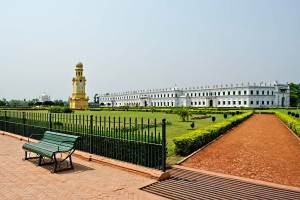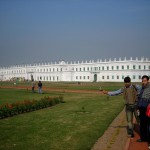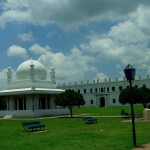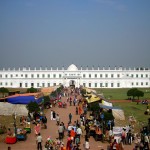Imambara, also known as the Nizamat Imambara, is the masterly creation of Nawab Nazim Mansoor Ali Khan Feradun Jah, the heir of Nawab Nazim Humayun Jah, his father in Murshidabad, West Bengal. The mosque was constructed in 1847 following the infernos of 1842 and 1846 as a result of which the Imambara made of wood constructed by Nawab Siraj ud-Daulah was destroyed.
About the Nizamat Imambara
The Nizamat Imambara is the biggest of its kind in West Bengal and India. The shrine lies just facing the Hazarduari Palace. The distance from the Bhagirathi River is only a stone’s throw. Approximately Rs.6 Lakhs was spent for the construction work. The building work required 11 months to finish.
- Imambara, West Bengal
- Imambara Closer View, Murshidabad
- Imambara Entry Gate, West Bengal
Previous Nizamat Imambara
Nawab Siraj ud-Daulah constructed the previous Nizamat Imambara in the Nizamat Fort region. The foundation stone laying ceremony was performed by him and he also purchased the building materials for constructing this architectural wonder on his own initiative. The site where the Imambara was constructed was plowed six feet deep. Subsequently, the sacred soil of Mecca was used to replenish the hole in order that the underprivileged population of the Muslim society can become familiar with the sacred journey to Mecca.
Devastation
The original Imambara was wooden and went up in flames initially in 1842 and was ruined in part. Subsequently, it was devastated again once an inferno gutted it entirely on December 23, 1846. On that day, the Nawabs together with the Europeans were rejoicing the weaning rituals of Hassan Ali Mirza who was just five years old at that time by a gathering. During the middle of the night, the Imambara was conflagrated as a result of the firecrackers left over and was fully destroyed. Not a single object could be protected other than the Madina Mosque.
New Nizamat Imambara

The erstwhile Madina Mosque was left in its position where it remained in the previous Imambara. In addition, a new masjid was built inside the newly built Imambara. You can still view the previous Madina Masjid, situated amid the Hazarduari Palace and the Imambara, close to the Clock Tower and the Bacchawali Tope (cannon- 18 foot in length and 16880 pound. In Bengali “Baccha” means baby. It was believed that the cannon produced such a deafening sound that pregnant ladies gave birth to their babies when the sound reached their ears—hence the name “Bacchawali Tope—tope is hindi for cannon). The place is popularly called as Madina, its previous name. As a result of this, visitors get puzzled between the new and old one. Check out the Nawabs’ pleasure ground Roshni Bagh as well in Dahapara.
Sadeq Ali Khan was the overseer of the new Imambara which was constructed in 1847 AD. The principal gateway is south facing and lies just opposite to the northern side of the Hazarduari Palace. The craftsmen just required eleven months for completing the building since over and above their remuneration, they got food as well which enabled them to labor round-the-clock.
The length of the current Imambara is 680 feet. Nonetheless, the widths differ. The middle portion which houses the Madina has a length of 300 feet. The section was constructed marginally few feet away from the location of the earlier edifice to the north. The Imambara lies on the riverbanks of the Bhagirathi. The difference between the coasts of the river and the western fence of the shrine is just 2-3 feet.
The religious site has been segmented into three big rectangles as explained below:
- The rectangle to the east is home to the Nowbat Khana
- The rectangle in the middle houses the Memberdalan and the Madina Mosque
- The rectangle to the west is home to a mosque with two floors. It lies on the Mint Ghat and ascends nearly from the Bhagirathi since the gap is only 1-2 feet.
Image Source: Flickr/Tarun Pradhan



